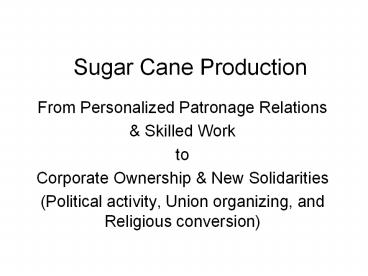Sugar Cane Production PowerPoint PPT Presentation
1 / 21
Title: Sugar Cane Production
1
Sugar Cane Production
- From Personalized Patronage Relations
- Skilled Work
- to
- Corporate Ownership New Solidarities
- (Political activity, Union organizing, and
Religious conversion)
2
Some key dates in Puerto Rican History
- 1508 Spanish colonization of the island
- Transition to sugar monoculture, 18th century
- Abolition of slave trade in the Atlantic, 1807
- End of slavery, 1874
- Spanish-American war, 1898 US gained dominion
over Cuba and Puerto Rico
- A Wisconsin troop arriving in PR
3
The Triangular Trade
4
(No Transcript)
5
Slaves cutting sugar cane, 1823
- Approximately 10 million people taken from Africa
over 400 years - 5.5 million taken in the 100 years of the 18th
century - Decade of the highest number 1780s
6
Capitalist Agriculture Sugar Plantations
- Dependent on unfree (slave) labor which was
imported from Africa - Product was a commodity (grown to be sold for
cash) - Product was exported important for the caloric
needs of the working-classes in Europe who
themselves had lost access to the land - Sugar is not really a source of food and
nutrition people can go hungry - Sugar cane required vast inputs of labor
planting, plowing (p. 58-59), harvesting,
irrigating, processing/burning into sugar and rum - Monocrop agriculture lack of diversification in
the economy which makes it more vulnerable to
shifts in the world economy
7
(No Transcript)
8
Sugar cane plantations after slavery
- Personal relations of domination and control
- Sugar cane plantations owned by a family who
lived near the land (case of Pastor Diaz) who
functioned paternalistically and sometimes
brutally - Foremen (mayordomos) were sought after as
compadres (p. 159-160) - Some laborers were resident on the plantations
and others were not (p. 169-170) - Explain piecework p. 70, 131, 136, 137
- Skilled (palero digging) and unskilled jobs, p.
135 - Children worked on the land at a young age (when
did Don Taso begin working? Compare to Nisa.) - People supplemented their income by growing their
own crops on unused land (p.159).
9
The landowners had political as well as economic
control. What did they do to maintain their
political power, particularly when challenged by
other parties?
10
How did Don Taso survive his blacklisting?
11
Changes in Sugar Cane Agriculturein Don Tasos
lifetime
- US investment went into sugar cane plantations
- US corporations (Aguirre) owned by US banks
bought up or rented land from the landowning
families - Aguirre controlled 95 of the land in the
municipality of Barrio Jauca - They also took the common land which people were
using to keep cows or grow food, so people were
more dependent on a cash wage - The landowning families moved to the cities or to
the US or Europe (p. 207) Don Pastor Diazs
family went to San Juan - Loss of personal relations (one could not curry
favor with a company in the way one could with a
family over generations)
12
Changes in Sugar Cane Agriculture in Don Tasos
lifetime
- Corporations introduced new techniques new
mills with increased grinding capacities,
internal railroad networks, electrification, and
internal combustion engines. - Skilled labor less necessary now all workers
were the same
13
Stratified Societies
14
Changes in Sugar Cane Agriculture results in
Political Class-based Solidarities
- Conversion from social stratification based on
personal relations to a class system based on
relations to the mode of production - Workers were now completely a rural proletariat
poor, landless, wage-earning, buying all their
goods from the stores. - Because there was now more identification between
them, they began to organize themselves and feel
themselves to be a social class of
workers---Socialist and Popular parties gained
power and unions were formed.
- Translation Celebrate Labor Day. The day workers
are respected. Long live Santiago Iglesias Pantin
(labor leader).
15
After World War II
- US investment in light industries, where women
worked pharmaceutical, textile - US encouragement of Puerto Rican migration, first
as seasonal farm workers - Widespread emigration to the US
- Puerto Rican poverty
16
(No Transcript)
17
(No Transcript)
18
(No Transcript)
19
(No Transcript)
20
(No Transcript)
21
Current Political Status of Puerto Rico
- Puerto Rico is not an independent country.
- It is a non incorporated territory. According
to the United States Supreme Court, an
unincorporated territory is a territory
appurtenant and belonging to the United States,
but not a part of the United States. - Its current powers are delegated by the US
Congress and are not fully protected by the US
Constitution. - The Federal Relations Act of 1950 and the
Constitution of 1952 gave Puerto Rico
substantially more authority to regulate local
affairs. - Otherwise its laws are those of federal laws.
- Puerto Rico is not a state of the Union and has
no voting representative in the United States
Congress. - The Jones-Shafroth Act of 1917 gave US
citizenship to Puerto Ricans.

